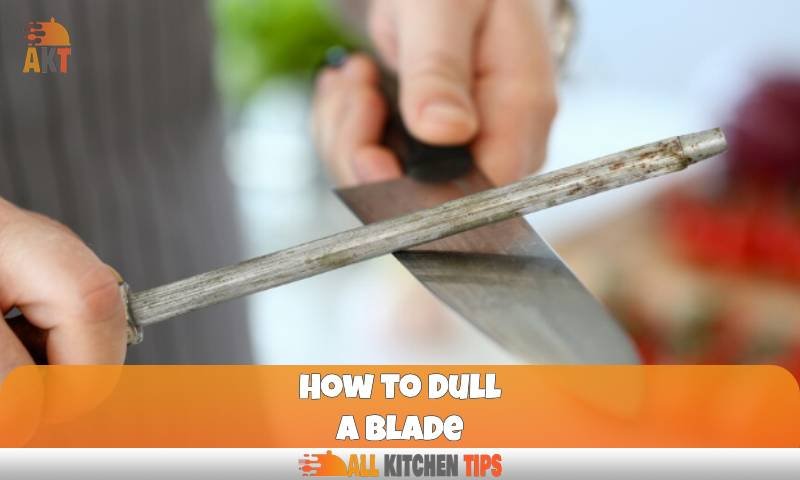To dull a blade, you can use a sharpening stone or sandpaper to wear down the edge. Dulling a blade may be necessary in certain situations, such as when you need to make it safer for handling or to prevent accidental injury.
Using a dull blade on a surface can also help prevent scratching or damaging delicate materials. While it may seem counterintuitive, dulling a blade can have its benefits. We will discuss various methods to effectively dull a blade without causing any harm.
Whether you are working with a knife, box cutter, or any other sharp implement, these techniques can help you achieve the desired level of bluntness safely and efficiently. So, let’s dive into the details of how to dull a blade without any hassle.
What Is Blade Dulling
Blade dulling is the process by which a blade becomes less sharp over time and use. There are several reasons why blades become dull. First, frequent use can cause the blade’s edge to wear down. Second, cutting hard materials or objects can quickly dull a blade.
Third, improper storage and maintenance can also contribute to blade dulling. Additionally, using a blade on the wrong type of material can lead to dullness. It is important to dull a blade for safety purposes. A dull blade is less effective and requires more force to cut, increasing the risk of accidents.
Therefore, regular blade maintenance, including sharpening and proper storage, is crucial to avoid accidents and ensure optimal performance. Ultimately, prioritizing blade maintenance and understanding the reasons for blade dulling is essential for safety and efficiency.
Why You Should Dull A Blade

Dulling a blade offers enhanced safety when handling tools, as it reduces the risk of accidents. A dull blade is less likely to slip, preventing potential injuries and ensuring a more secure grip. By intentionally dulling a blade, you can also control the cutting depth, allowing for greater precision while working on delicate materials.
Additionally, a dull blade reduces the chances of causing damage to the tool or workpiece, as it requires less force to cut. This prolongs the lifespan of the blade and saves you money on frequent replacements. So, despite the common belief that a sharp blade is always better, there are indeed advantages to using a dull blade when it comes to safety and precision.
Take these factors into consideration when working with tools to ensure a safe and efficient working environment.
Understanding Different Blade Dulling Techniques
Understanding different blade dulling techniques is essential for maintaining the longevity of your blades. There are various methods available that can effectively dull a blade and prevent it from becoming too sharp. By comparing the effectiveness of these techniques, you can choose the most suitable one for your needs.
One commonly used technique is using sandpaper to wear down the blade’s cutting edge. Another method involves using a grinding stone to remove the sharpness. Additionally, you can opt for chemical agents that gradually deteriorate the blade’s cutting abilities. Remember, each technique has its own advantages and disadvantages, so it’s crucial to weigh them carefully.
By properly understanding and implementing these blade dulling techniques, you can ensure optimal performance and safety for your blades.
Backing Method: The Classic Technique
The classic technique for dulling a blade is the backing method. To achieve optimal results, follow these step-by-step instructions. Begin by positioning the blade on a rough surface. Apply light pressure and move the blade in a back-and-forth motion. Repeat this process multiple times until the desired level of dullness is achieved.
Remember to avoid overdoing it, as excessive dullness can render the blade ineffective. Additionally, be mindful of your safety during this process by wearing gloves to protect your hands. In conclusion, the backing method is a reliable way to dull a blade effectively and safely.
Experiment with different surfaces and pressures to find the perfect balance for your needs. Enjoy the process of maintaining your blades’ sharpness for a longer lifespan.
Grinding Method: Restoring Blunt Edges
The grinding method helps restore blunt edges by using recommended tools for blade grinding. Safety precautions should be followed during the process to avoid accidents. Effective grinding can dull a blade, ensuring its optimal performance. It is important to understand the technique and its benefits.
Using the right tools, such as a sharpening stone or grinder, is crucial for successful grinding. It is advisable to wear protective goggles and gloves to prevent injuries. Always maintain a steady hand and a consistent angle while grinding to achieve the desired result.
Take breaks in between grinding to prevent overheating of the blade. The grinding technique is an efficient and cost-effective way to restore the sharpness of a blade, enhancing its usability and longevity.
Abrasive Media Method: Quick And Effective
The abrasive media method is a quick and effective way to dull blade edges. Selecting the right media for each type of blade is essential. This method offers several benefits, but it also has its limitations. The key is to choose the appropriate media that will wear down the blade without causing damage.
By following this method, you can easily and efficiently dull your blade for various purposes. It’s important to note that different blades may require different types of media. Therefore, it’s crucial to understand the specific needs of your blade and select the media accordingly.
Keep in mind that this method may not be suitable for all blades and situations. It’s always recommended to exercise caution and ensure the safety of yourself and others when working with blades.
Corrosion Method: Safe Rusting Process
Inducing corrosion on blades can safely dull them without causing excessive damage. By using rusting as a method, blades can become less sharp over time. However, precautions should be taken to prevent any unnecessary harm to the blade. It is important to ensure that the rusting process is controlled and monitored to avoid excessive corrosion.
Regular inspection and maintenance of the blades can help prevent any severe damage. By following these guidelines, you can effectively dull a blade without compromising its integrity. Remember to handle the process with caution and prioritize safety to achieve optimal results.
Friction Method: Rubbing Blades For Blunting
Dulling a blade can be achieved using the friction method, specifically by rubbing the blades together. This technique involves using certain materials to create friction on the edges of the blade, resulting in blunting. Recommended materials for this method include sandpaper, a ceramic plate, or a sharpening stone.
However, it’s important to consider the advantages and drawbacks of using this friction-based method. On the positive side, it is a simple and accessible way to dull a blade without the need for any specialized tools. However, it may not be as effective as other methods, such as sharpening or using a dulling agent.
In addition, this approach may cause uneven blunting or damage to the blade if not performed carefully. Therefore, caution and precision are crucial when using the friction method to dull a blade.
Chemical Method: Acidic Solutions For Dulling

Dulling a blade can be achieved through the use of acidic solutions. Different blade types require specific acid selections. Always prioritize safety precautions when handling acids to ensure a secure working environment. By following these guidelines, you can effectively dull blade edges using acids.
FAQ
How Can I Dull A Blade Without Damaging It?
To dull a blade without causing damage, you can rub it against a rough surface or use sandpaper.
What Are The Dangers Of Using A Dull Blade?
Using a dull blade can lead to injuries, as it requires more force and can slip easily.
Is It Possible To Dull A Blade Temporarily?
Yes, you can temporarily dull a blade by covering it with adhesive tape or using a dulling spray.
What Are The Benefits Of Dulling A Blade?
Dulling a blade can be useful for specific tasks, like cutting delicate materials or avoiding accidental cuts.
Conclusion
Dulling a blade is a methodical process that requires patience and the proper tools. By following the steps outlined in this blog post, you can effectively dull a blade without causing any damage or injury. Whether you’re working with a kitchen knife, a utility knife, or a hunting knife, the techniques mentioned can be applied to any type of blade.
Remember to prioritize your safety by using protective gear and working in a well-ventilated area. Dulling a blade can be beneficial in various scenarios, such as when sharpening is not desired or when a dulled blade is needed for specific tasks.
By implementing these tips, you can maintain the longevity of your blades and ensure they remain as sharp as possible for their intended use.





